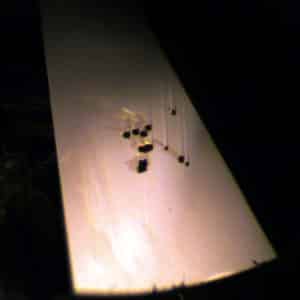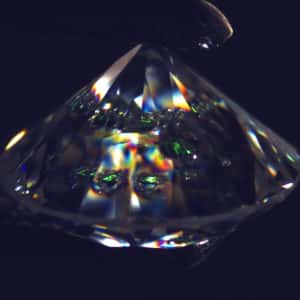By Wade Abel, CG, Director of Gemological Services, AGS Laboratories
Welcome to Under the Scope! In this segment, we will explore some of the interesting and unusual things as seen under magnification. The microworld of diamonds can be unique, insightful, and beautiful!
Interesting Inclusions
With all of the diamonds sent to AGS Laboratories, we often see interesting or unusual inclusions. Sometimes these result from what was included in the diamond during the growth process or are evidence of the growth process itself. Either way, these are a result of natural growth and give us insight into the conditions in which these diamonds grew.
We will feature two diamonds submitted by John Carter, CGA, of Jack Lewis Jewelers. John is also the Chair of the AGS Laboratories Advisory Committee.

The Etch Channels
This diamond has an incredible display of etch channels that extend all the way from the pavilion to the table. The channels radiate in a pattern consistent with a diamond’s growth pattern. In addition, the presence of oxidation in the channels is unique and gives them their golden color.
Because of this coloration, the etch channels resemble rutile needles (occasionally found in quartz) when the diamond is viewed at a lower magnification.
In the images above, this example is spectacular with etch channels that are dramatic and extend in this beautiful pattern through the diamond.
Looking at the reflected surface of one of the pavilion facets, you can clearly see the somewhat rectangular openings of the channels. Etch channels are most likely caused by high-temperature fluids that etch, or dissolve into the diamond crystal.
The “Diopside” Diamond
Although we cannot be 100% sure of the identification of these amazing green crystals in this diamond, a good guess could be that these are diopside. Diopside, among other minerals, grows alongside diamond in peridotite—a type of magma deep within the earth.
When the diamond is forming, it may envelop the crystals of other minerals, trapping them as evidence of where these diamonds grew. Other potential identifications for these green crystals could be garnet or olivine.
When viewed with cross-polarized lenses, the colorful strain patterns not only create a beautiful image, they also show that there is localized strain around these crystals.
Small stress fractures around the included crystals are also evidence of this strain. The result, however, is stunning! Take a look at the image below.
If you have any interesting diamonds or diamonds with interesting features, please let us know at [email protected]. We would love to see them and, who knows, they may be featured in “Under the Scope!”

